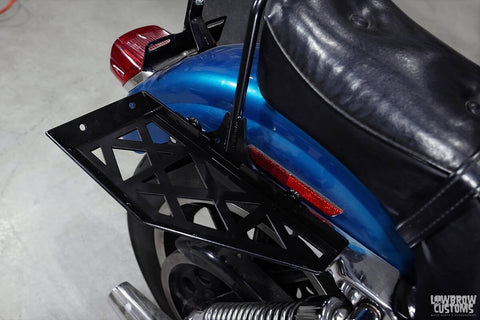New Technology
Every time a new technology comes out there tends to be a lot of questions around that technology. For example, LED headlights are a great innovation for motorcycles. Adding an LED headlight to your bike really can improve your ability to see at night. The light is brighter, it uses less power, the bulbs are durable, vibration resistant, and they don’t get hot. They are simply, a great improvement.
Believe it or not, when the first LED bulbs came out, there were a lot of people that thought they were inferior to incandescent bulbs.
Another product that has been great in recent years, is the innovation in lithium batteries for motorcycles! Lithium batteries have a ton of advantages over typical conventional and AGM batteries.
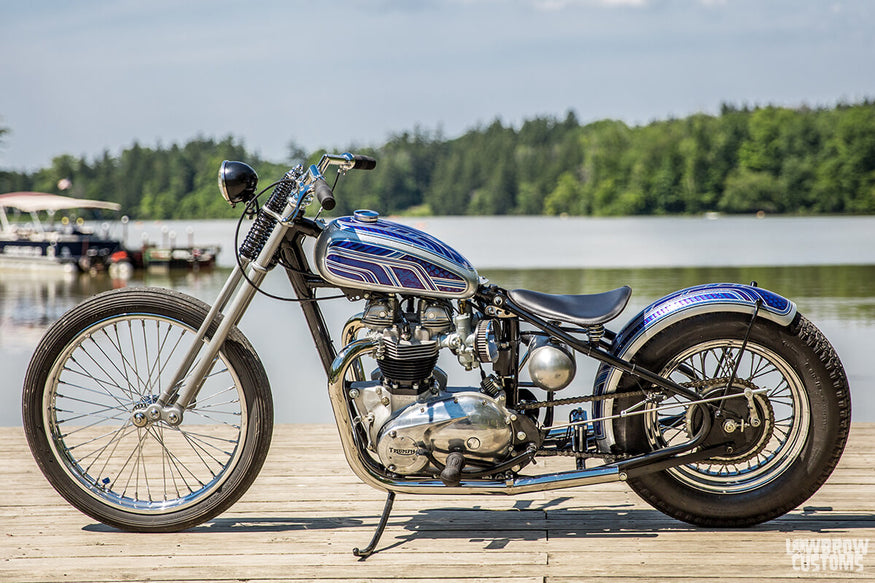 One of Todd's Classic Triumph builds utilizing an Antigravity 4 cell lithium battery that is super small and compact, giving a sleek and stylish look.
One of Todd's Classic Triumph builds utilizing an Antigravity 4 cell lithium battery that is super small and compact, giving a sleek and stylish look.
Lithium Battery Advantages
Weight
The first benefit is weight. Lead acid batteries are heavy. Anytime you can remove weight from your motorcycle, you gain power. If you take a bike to a dragstrip and you have a rider that weighs 200 lbs and a rider that weighs 150 lbs. If they ride the bike exactly the same, the 150 lb rider is going to have a faster time.
This is typically referred to as a power-to-weight ratio. Lithium batteries are typically 70% lighter than AGM batteries. On a motorcycle, this is a big advantage.
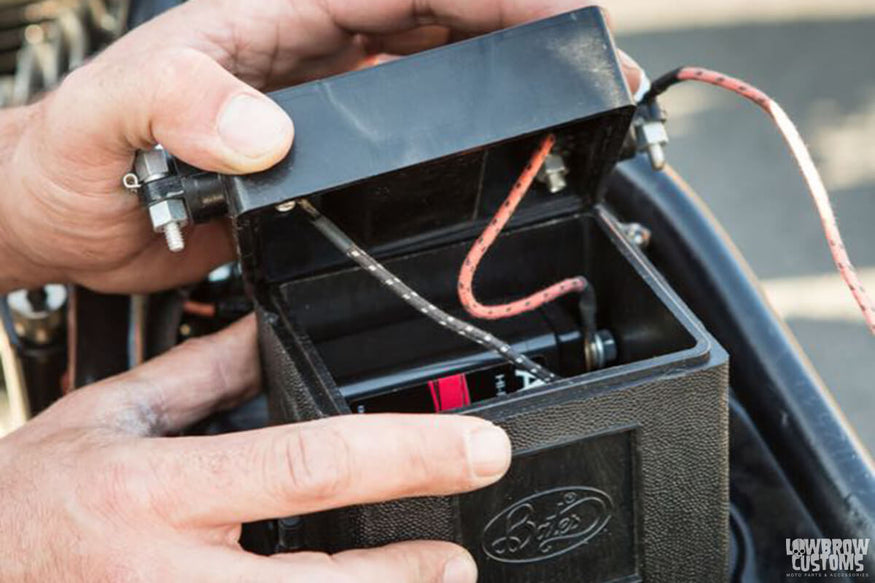 Some lithium batteries are so small you can use a custom battery box (such as this Antigravity 4 Cell Battery in a Bates Batboy battery box) to hide it and still have room for tools and other carry on goods. Photo compliments of W&W.
Some lithium batteries are so small you can use a custom battery box (such as this Antigravity 4 Cell Battery in a Bates Batboy battery box) to hide it and still have room for tools and other carry on goods. Photo compliments of W&W.
Cycle Life
Another advantage is cycle life. Lithium batteries have a much better cycle life than an AGM battery does. Now there are a lot of caveats that affect your cycle life. How often you use the battery, how much strain is on the battery during use, temperature, etc.
The point is a lithium battery can do around 3000 cycles compared to an AGM producing about 500 cycles. Lithium batteries are definitely more expensive than most AGM batteries, but they perform much better typically, and have a longer life span.
 Lithium batteries can be mounted pretty much anywhere. Tyler mounted this Antigravity 16 cell on the tail section of his new dual engine Triumph land speed race bike, that is hidden by the tail section.
Lithium batteries can be mounted pretty much anywhere. Tyler mounted this Antigravity 16 cell on the tail section of his new dual engine Triumph land speed race bike, that is hidden by the tail section.
Mounting Position and Vibration Resistance
Lithium Batteries can be mounted vertically, horizontally, or upside down. This is a big benefit for custom builders because it gives them more options for mounting the battery.
There are various brands and options for easily mounting a lithium battery using a purpose-built custom battery box for motorcycles. Along with some various mounting brackets available, there are now bolt-on options to securely mount the battery in your chopper or custom motorcycle without having to do much (or any) welding and fabrication.
Lithium batteries also can handle more vibration that an AGM battery. AGM batteries have an assortment of plates in them. These plates are soldiered to connectors that lead to the main post on the battery. A lot of vibration can cause these connections to break.
Lithium batteries do not have any liquid in them, and the lithium packs inside are very durable compared to the construction of a Conventional or AGM battery. It’s not common to see a decent lithium battery fail due to vibration. Just ask anyone riding a modern motocross bike. These bikes are often flipped, jumped, and crashed, and they all have lithium batteries in them.
 You can see in this photo the sheer size difference in an Antigravity 12 cell battery to a stock OEM Harley-Davidson Sportster Battery is staggering. Being able to use a smaller battery such as this 12 cell can definitely help when designing a clean and tight custom chopper.
You can see in this photo the sheer size difference in an Antigravity 12 cell battery to a stock OEM Harley-Davidson Sportster Battery is staggering. Being able to use a smaller battery such as this 12 cell can definitely help when designing a clean and tight custom chopper.
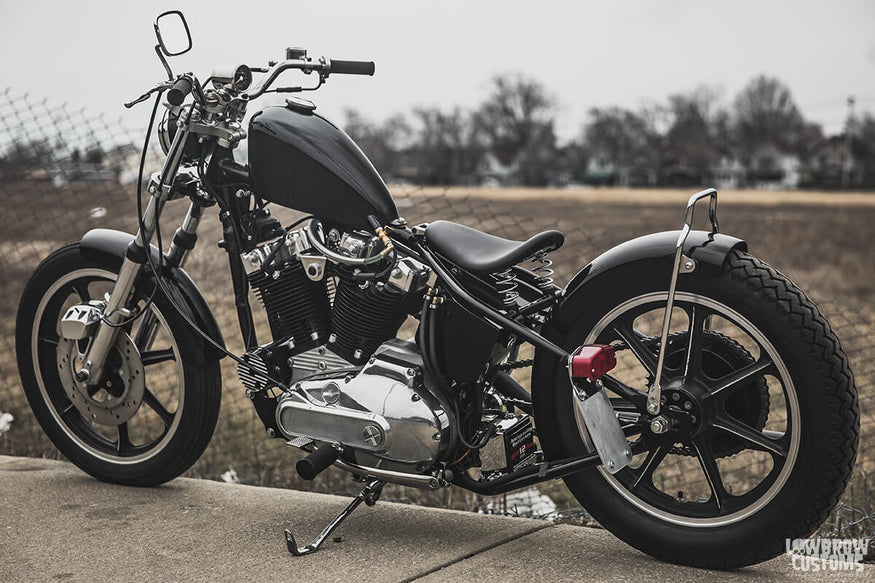 This Gasbox built Ironhead Harley-Davidson Sportster has an Antigravity 12 cell powering it up and works extremely well for this electric start motorcycle.
This Gasbox built Ironhead Harley-Davidson Sportster has an Antigravity 12 cell powering it up and works extremely well for this electric start motorcycle.
Power
Lithium batteries offer really good CCA (cold cranking amps) when compared to the same AGM battery. The one down side is Lithium batteries do not do well in sub-freezing temperatures, or if they are left un-used for extended lengths of time. If you live in a cold climate, take your lithium battery out of your bike in the off-season and store it in your house. This will ensure it’s longevity.
 Using a "Smart battery charger" or something like this Noco Genius 2 set up you can select on hook up what kind of battery you are charging to ensure you are not damaging the battery. A smart investment if you are going to be running these lithium style batteries.
Using a "Smart battery charger" or something like this Noco Genius 2 set up you can select on hook up what kind of battery you are charging to ensure you are not damaging the battery. A smart investment if you are going to be running these lithium style batteries.
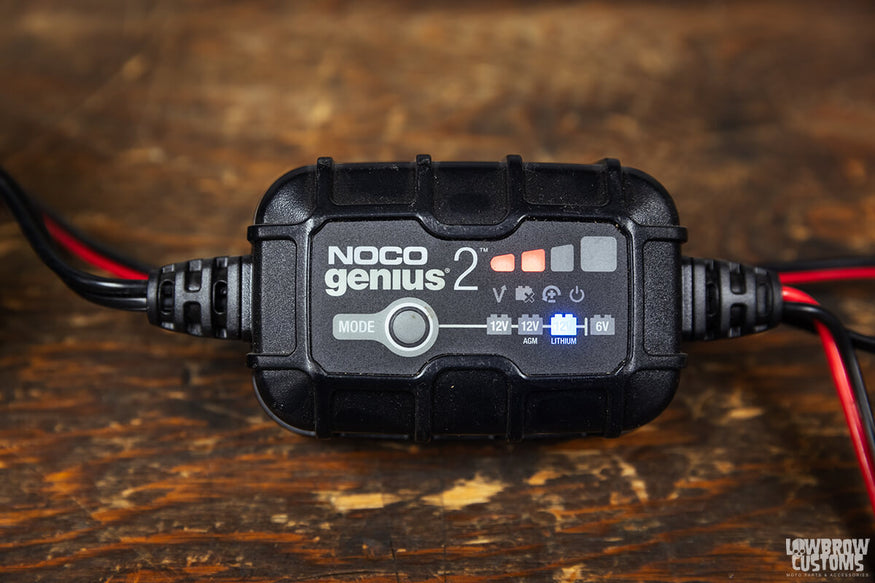 You can see this charger is in Lithium 12 volt mode and charging the battery correctly right on the device.
You can see this charger is in Lithium 12 volt mode and charging the battery correctly right on the device.
Charging and Maintaining a Lithium Battery
If you look at some of the reviews on lithium batteries you will often see a lot of questions concerning charging these batteries. Lithium batteries require a different type of battery charger that delivers the power in a different manner than your typical battery charger designed for AGM or conventional batteries.
In simple terms, battery chargers rely on a discharge profile that tells the battery charger what to do. Lead acid batteries have a very different discharge profile than a lithium battery. This means your AGM charger will make a mistake when charging a lithium battery, which can damage that battery.
You can also overcharge or undercharge a lithium battery with a regular charger, and this can also damage your lithium battery. You need to have a lithium battery charger that has an automatic shut-off when it hits the 12.8v mark.
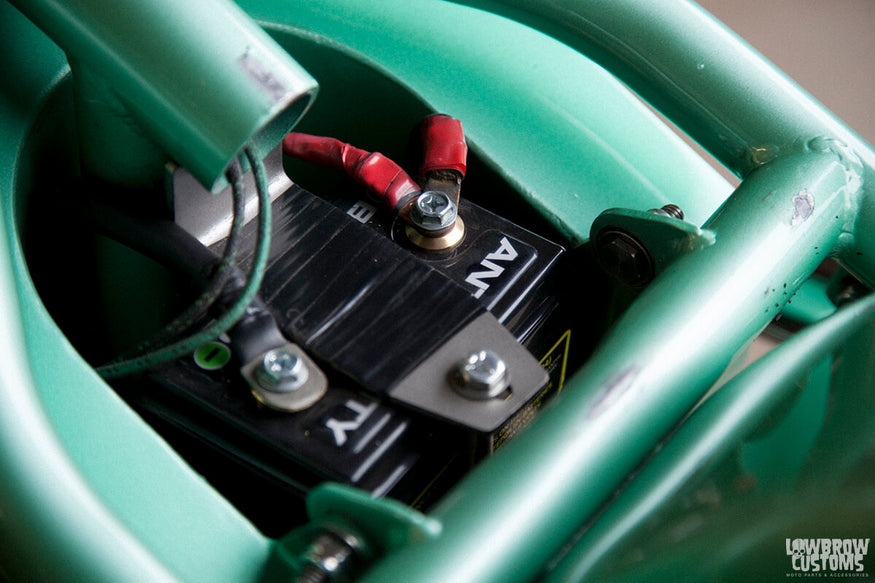 Antigravity 12 cell in one of the Haifley Bros builds, tucked tightly inside an oil bag.
Antigravity 12 cell in one of the Haifley Bros builds, tucked tightly inside an oil bag.
Another common scenario is when people accidentally completely drain their lithium battery. When they hook up their lithium battery charger, the charger does not see a profile, so it does not charge the battery. These chargers are made to see a threshold. If the charger does not see that threshold charge, it thinks the battery is defective and will not charge it.
Jump the Charging Process
Your lithium battery charger will not charge your battery? If the battery is not truly defective, all you need to do is get the battery up to a charge threshold for a moment so the lithium battery charger begins the charging process.
To do this, simply use a set of jumper cables from a good lithium battery and hook them up to the battery you are trying to charge. Make sure you connect positive to positive and negative to negative. Now connect your lithium battery charger to your old battery and turn it on.
Once you see the charging light come on, disconnect the good battery you are not trying to charge. Your lithium battery charger will now charge your lithium battery. It’s really that simple.
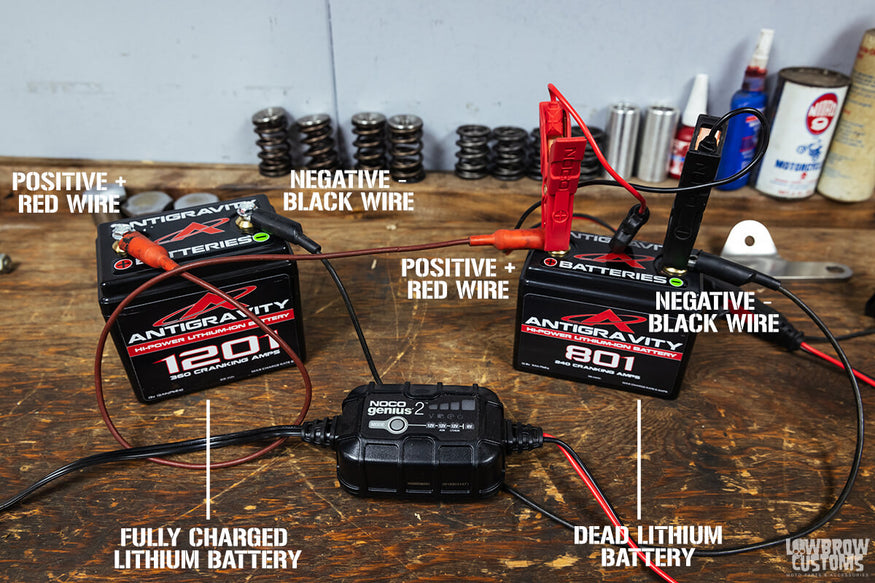 Note: Only do this jump start from a charged lithium battery to a not charged lithium battery. Trying this process with any other type of battery could damage both.
Note: Only do this jump start from a charged lithium battery to a not charged lithium battery. Trying this process with any other type of battery could damage both.
If you are looking to replace your battery, consider buying a lithium battery. If you don’t live in Antarctica, it is a good choice. More power, longer life, less weight, and better durability. Lithium batteries are here to stay, so best to get in tune with the technology.
Here are some more photo examples of lithium batteries on other bikes and how they can make it super clean look and still work fantastically.
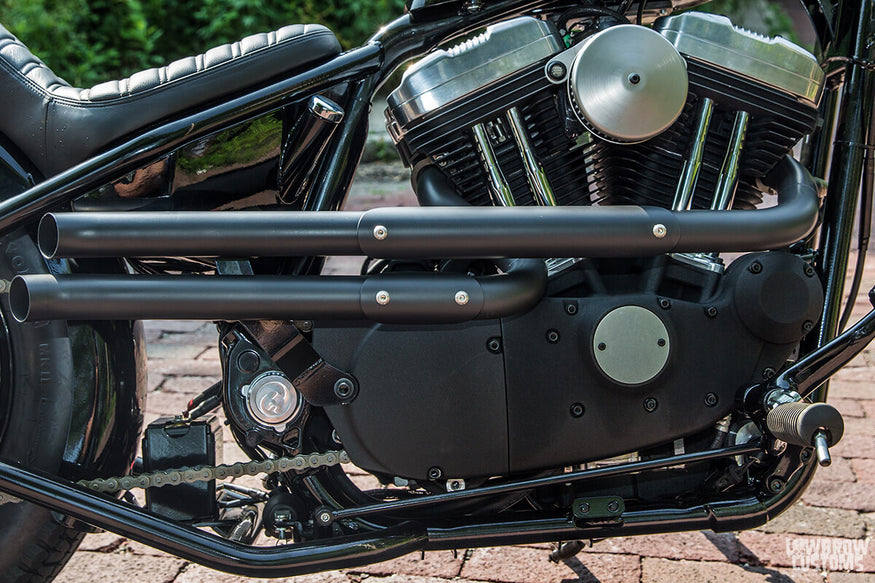 Gasbox Sportster with an Antigravity 16 cell.
Gasbox Sportster with an Antigravity 16 cell. Another one of Todd's classic Triumphs with an Antigravity 4 cell.
Another one of Todd's classic Triumphs with an Antigravity 4 cell. Closer look on how Todd mounted this using a LC Fab 4 Cell Battery box.
Closer look on how Todd mounted this using a LC Fab 4 Cell Battery box.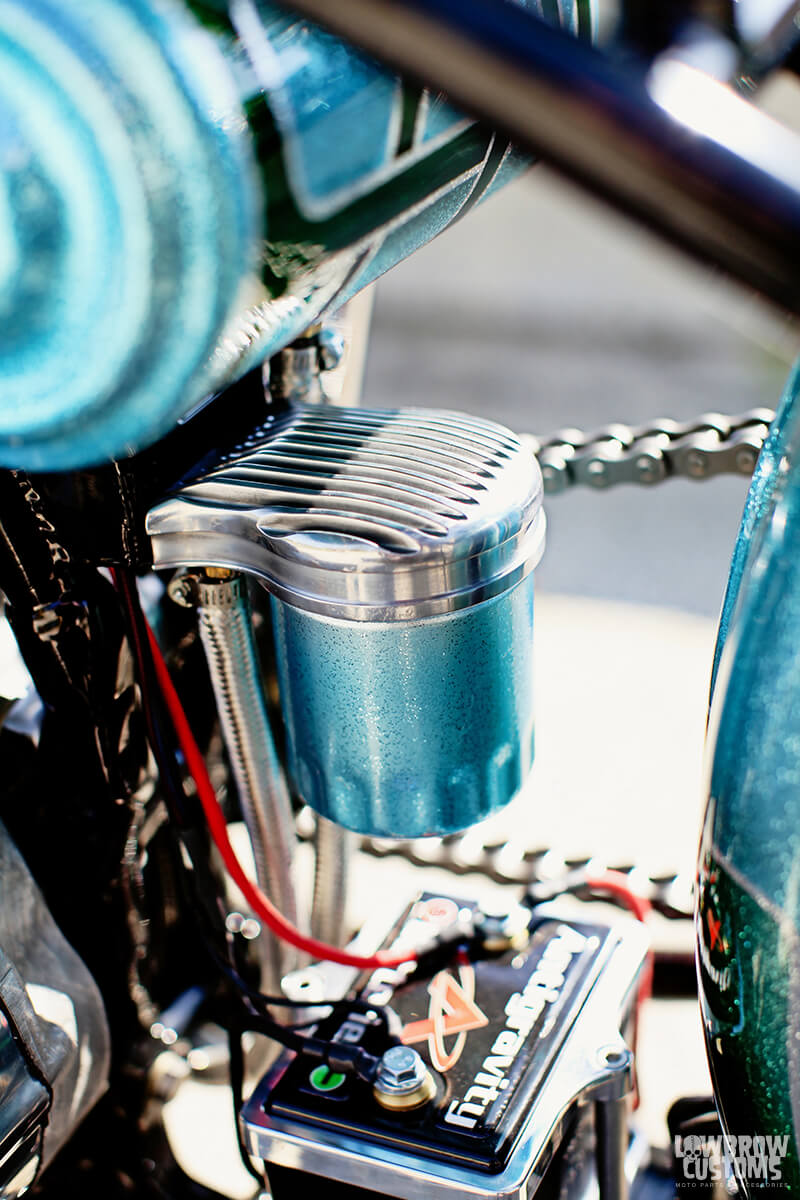 Greg's Ironhead with an Antigravity 12 cell.
Greg's Ironhead with an Antigravity 12 cell. Led Sled Customs build with an Antigravity 12 cell.
Led Sled Customs build with an Antigravity 12 cell.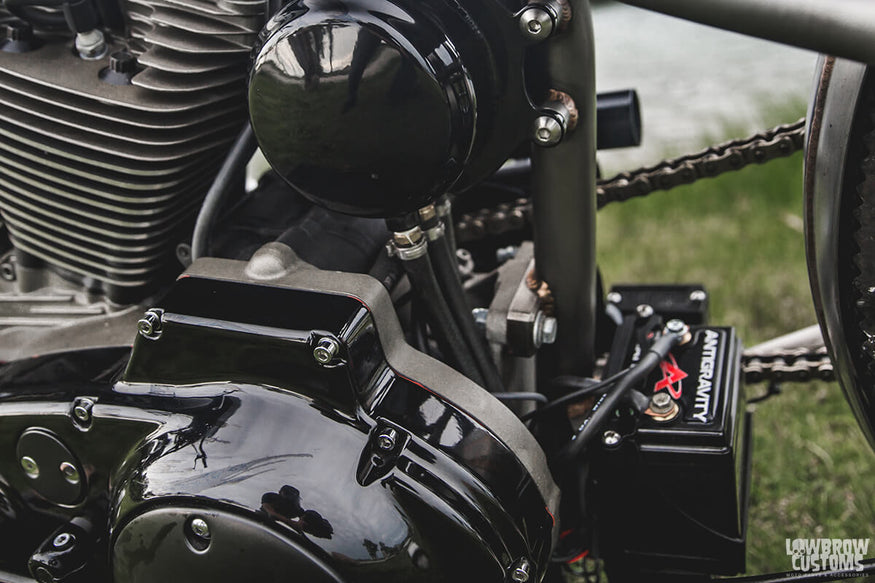 Another Led Sled build with an Antigravity 12 cell.
Another Led Sled build with an Antigravity 12 cell. Some of the Antigravity Lithium Batteries we sell here at Lowbrow Customs
Some of the Antigravity Lithium Batteries we sell here at Lowbrow Customs
Related Products










